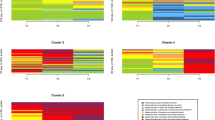Abstract
Objectives: To identify existing programs serving 11- to 15-year-olds that aim to improve adolescent health in the areas of Health & Well-being, Fitness, Family & Peer Relationships, School Environment, Smoking, Alcohol Use, and Violence and to assess the utility of readily available resources in providing detailed program information. Methods: In Phase 1, publicly available program databases were searched to identify potential programs serving the target population. In Phase 2, an in-depth search of a limited sample of programs meeting the content and age criteria was performed to identify program descriptors. Results: Over 1,000 program names were identified in Phase 1. Information regarding programs is becoming more readily available through the internet; however, the program information that was publicly available only begins to draw the picture. Phase 2 revealed that a broad array of efforts are underway in all seven content areas, but found information on the program descriptors to be limited. Conclusions: Investment in programming is not enough; an upfront investment in communication and information sharing is critical in order to maximize the resources dedicated to the improvement of adolescent health. A well-publicized centralized program repository offered in conjunction with technical assistance would provide an efficient mechanism for this information sharing. We further suggest that the inherent gap between research and practice can be lessened by building a new body of practice knowledge. This would require improved program data collection by programs, the incorporation of program participation information in national surveys and enhanced evaluation efforts.
Similar content being viewed by others
Notes
Some topics were not included in the HBSC survey by all countries and therefore did not allow for comparison.
References
Currie C, Hurrelmann K, Settertobulte W, Smith R, Todd J. Health and health behavior among young people. Health Behavior in School-aged Children: A WHO cross-national study (HBSC) international report. Copenhagen, Denmark: Health Promotion and Investment for Health, World Health Organization Regional Office for Europe, 2000.
Biehl MC, Park MJ, Brindis CD, Pantell RH, Irwin CE, Jr. The health of America’s middle childhood population. San Francisco, CA: University of California, Public Policy Analysis and Education Center for Middle Childhood and Adolescent Health, 2002.
Brindis CD, Biehl MC, Park JM, Pantell RH, Irwin CE, Jr. Building a Strong Foundation: Creating a health agenda for the middle childhood Years. San Francisco, CA: University of California, Public Policy Analysis and Education Center for Middle Childhood and Adolescent Health, 2002.
U. S. Department of Health and Human Services. Health resources and services administration. U.S. Teens in Our World. Rockville, Maryland: Author, 2003.
White House Task Force for Disadvantaged Youth. White House Task Force for Disadvantaged Youth: Final report. Washington, DC: Author, 2003.
Brindis CD, Hair EC, Cochran SW, Cleveland K, Valderrama LT, Park MJ. Towards Meeting the Need of Adolescents: An Assessment of Federally Funded Adolescent Health Programs and Initiatives within the Department of Health and Human Services. San Francisco CA: University of California, National Adolescent Health Information Center, 2004.
SRI International. First 5 California: Child, family, and community indicators. Sacramento, CA: California Children and Families Commission, 2002.
Child Trends. Daily cigarette use. (2004). Retrieved December 2, 2004, from http://www.childtrendsdatabank.org/indicators/ 3Smoking.cfm.
Moore KA, Zaff JF. Building a better teenager: A summary of “what works” in adolescent development. Washington, DC: Child Trends, 2002.
Author information
Authors and Affiliations
Corresponding author
Rights and permissions
About this article
Cite this article
Brindis, C.D., Hair, E.C., Cochran, S. et al. Increasing Access to Program Information: A Strategy for Improving Adolescent Health. Matern Child Health J 11, 27–35 (2007). https://doi.org/10.1007/s10995-006-0143-6
Received:
Accepted:
Published:
Issue Date:
DOI: https://doi.org/10.1007/s10995-006-0143-6




